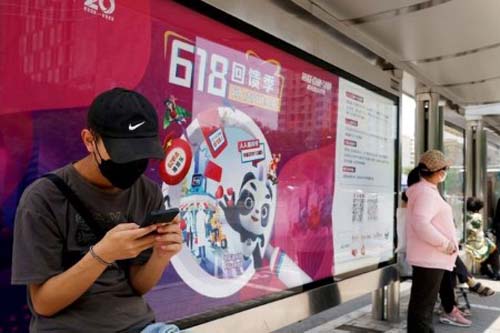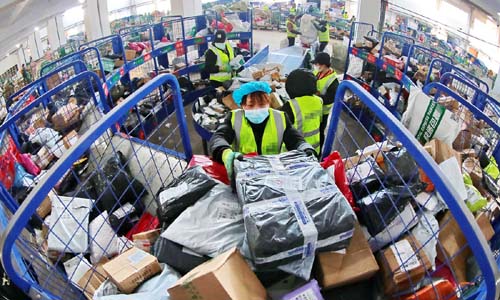Chinese ‘618’ shopping festival off to a good start after Omicron flare-up is contained

Global Times
Beijing: With the recent Omicron flare-ups largely put under control, consumption across many Chinese cities, restrained in the past two months during the resurgence, has significantly ramped up thanks to the government’s pro-growth policies and market events like the annual June-18 (618) shopping festival.
“I have received several goods I ordered during the pre-sell period,” a Shanghai resident surnamed Jiang told the Global Times on Saturday. As a keen online shopper, she stopped nearly all online shopping during the city’s two-month lockdown from April to May.
“There are still some on the way,” she said, noting that the delivery of several of her parcels seemed to have gotten stuck as logistics companies struggle to handle large amounts of orders.
Several parcel distribution centers of YTO Express were overstocked after the shopping festival began. The company has transferred staff from other cities to support the delivery in Shanghai city to cope with the hot season of consumption.
JD.com kicked off “peak 28 hours” of the shopping festival at 8 pm Friday. The turnover of 11 stores on the platform exceeded 100 million yuan in 10 minutes. Over 300,000 JD employees work on the frontline of warehousing and distribution, the company said.
In 10 minutes, the sale of cameras surged 400 percent year-on-year. Sales of smart phones rose 200 percent on JD.com, with domestic brand HONOR selling 100,000 handsets within one minute and the sale of Apple iPhones exceeding 100 million yuan in one second, according to data released by JD.com.

Though the “618” shopping festival was proposed by China’s e-commerce giant JD.com to celebrate the company’s founding anniversary, it has now become a nationwide shopping spree with nearly all shops and merchants on and off line taking the opportunity to boost sales.
Suning.com, which has both online and offline stores, told the Global Times Saturday that offline stores have led the spending recovery during this year’s shopping festival, with sales surging 182 percent year-on-year. Orders worth more than 70,000 yuan saw a 103-percent year-on-year increase, the company said.
“I was waiting for the festival to stock up on some necessities for my new-born baby,” a resident in Wuhan, Central China’s Hubei Province, told the Global Times. She bought clothes and other daily necessities for her son from both online and offline stores.
Another consumer based in Beijing told the Global Times that her shopping lists this year were quite different from previous years. “I bought some high-quality home appliances, such as a high-end coffee machine,” she said, noting that the COVID-19 pandemic has changed her life-style and she decided to focus on improving the quality of daily life at home.
An Italian coffee machine maker lamarzocco saw its sales on Alibaba’s Tmall.com surge by 6 times year-on-year on the first day of the shopping festiva.
Home appliances including dishwashers, sweeper robots, projectors and intelligent toilets for pets are seeing brisk sales as well, Tmall said, noting that “quality life” consumption is a trend of the shopping festival this year.
Tmall also stepped up incentivizing shopping efforts this year, increasing the usual 30-yuan reduction per 300-yuan consumption to deeper 50-yuan reduction. And, VIP consumers have got more coupons.
In addition to traditional e-commerce platforms, new innovative players such as livestreaming platform giant Douyin has also entered the new business arena.
Airliners have ramped up efforts to ensure transportation as well. From June 1 to June 15, China Southern carried a total of 48,000 tons of goods, up 19 percent month-on-month. The airline is expecting a second transportation peak from Saturday to Monday.
The Omicron flare-ups have hit China’s consumption hard. In May, China’s retail sales of consumer goods plunged by 6.7 percent on a yearly basis to end at 3.35 trillion yuan.
Tian Yun, a veteran economist, told the Global Times on Saturday he predicted that the consumption will start to pick up pace since June. In 2022, retail sales could rise by about 1-2 percent.





